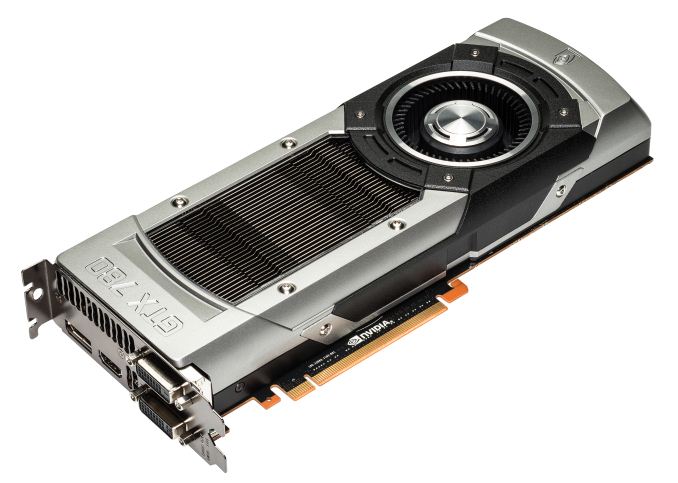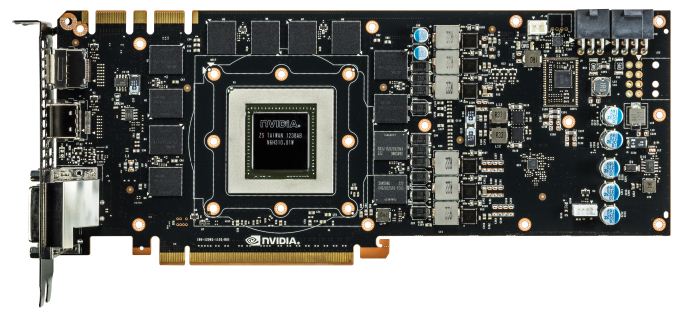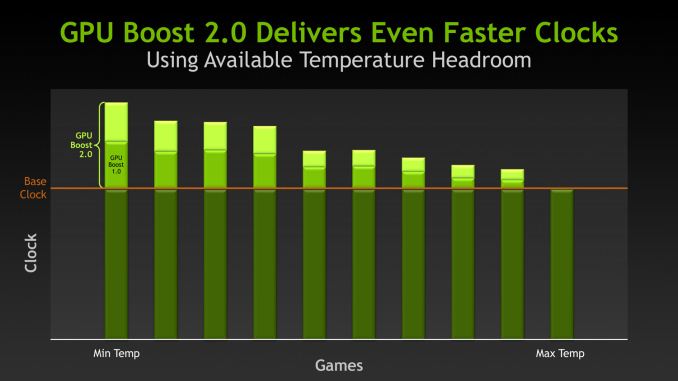NVIDIA GeForce GTX 780 Review: The New High End
by Ryan Smith on May 23, 2013 9:00 AM ESTMeet The GeForce GTX 780
As we previously mentioned, the GTX 780 is very much a Titan Mini in a number of ways. This goes for not only the architecture, features, and performance, but as it turns out it will be the case for the design too. For the reference GTX 780 NVIDIA will be straight-up reusing the GTX Titan’s board design, from the PCB to the cooler, and everything in between.
As a result the reference GTX 780 inherits all of the great things about the GTX Titan’s design. We won’t go into significant detail here – please read our GTX Titan review for a full breakdown and analysis of Titan’s design – but in summary this means we’re looking at a very well built blower design almost entirely constructed out of metal. GTX 780 is a 10.5” long card composed of a cast aluminum housing, a nickel-tipped heatsink, an aluminum baseplate, and a vapor chamber providing heat transfer between the GPU and the heatsink. The end result is that the reference GTX 780 like Titan before it is an extremely quiet card despite the fact that it’s a 250W blower design, while it also maintains the solid feel and eye-catching design of GTX Titan.
Drilling down, the PCB is also a re-use from Titan. It’s the same GK110 GPU mounted on the same PCB with the same 6+2 phase power design. This is part of the reason that GTX 780 has the same TDP as GTX Titan, while at the same time giving GTX 780 as much or more TDP headroom than Titan itself. Using the same PCB also means that GTX 780 has the same 6pin + 8pin power requirement and the same display I/O configuration of 2x DL-DVI, 1x HDMI, 1x DisplayPort 1.2.
Also being carried over from Titan is GPU Boost 2.0, which was first introduced there and has since been added to additional products (many GeForce 700M products already have it). GPU Boost is essentially a further min-maxed turbo scheme that more closely takes into account temperatures and GPU leakage characteristics to determine what boost bins can be used while staying below TDP. It’s more temperature dependent than the original GPU Boost and as a result more variable, but in cooler situations it allows tapping into that thermal headroom to hit higher clockspeeds and greater performance, TDP allowing. At the same time this means GTX 780 also gains GPU Boost 2.0’s temperature target functionality, which allows users to cap boost by temperature as well as TDP. As with Titan this limit is 80C by default, with the idea being that adjusting the limit is a proxy for adjusting the performance of the card and the amount of noise it generates.



















155 Comments
View All Comments
just4U - Thursday, May 23, 2013 - link
I love the fact that their using the cooler they used for the Titan. While I plan to wait (no need to upgrade right now) I'd like to see more of that.. It's a feature I'd pay for from both Nvidia and Amd.HalloweenJack - Thursday, May 23, 2013 - link
no compute with the GTX 780 - the DP is similar to a GTX 480 and way way down on a 7970. no folding on these thenBiffaZ - Friday, May 24, 2013 - link
Folding doesn't use DP currently, its SP, same for most @home type compute apps, the main exclusion being Milkyway@Home which needs DP alot.boe - Thursday, May 23, 2013 - link
Bring on the DirectCU version and I'll order 2 today!slickr - Thursday, May 23, 2013 - link
At $650 its way too expensive. Two years ago this card would have been $500 at launch and within 4-5 months it would have been $400 with the slower cut down version at $300 and mid range cards $200.I hope people aren't stupid to buy this overpriced card that only brings about 5fps more than AMD top end single card.
chizow - Thursday, May 23, 2013 - link
I think if it launched last year, it's price would have been more justified, but Nvidia sat on it for a year while they propped up mid-range GK104 as flagship. Very disappointing.Measured on it's own merits, GTX 780 is very impressive and probably worth the increase over previous flagship price points. For example, it's generally 80% faster than GTX 580, almost 100% faster than GTX 480, it's predecessors. In the past the increase might only be ~60-75% and improve some with driver gains. It also adds some bling and improvements with the cooler.
It's just too late imo for Nvidia to ask those kinds of prices, especially after lying to their fanbase about GK104 always slotted as Kepler flagship.
JPForums - Thursday, May 23, 2013 - link
I love what you are doing with frame time deltas. Some sites don't quite seem to understand that you can maintain low maximum frame times while still introducing stutter (especially in the simulation time counter) by having large deltas between frames. In the worst case, your simulation time can slow down (or speed up) while your frame time moves back in the opposite direction exaggerating the result.Admittedly I may be misunderstanding your method as I'm much more accustomed to seeing algebraic equations describing the method, but assuming I get it, I'd like to suggest further modification to you method to deal with performance swings that occur expectedly (transition to/from cut-scenes, arrival/departure of graphically intense elements, etc.). Rather than compare the average of the delta between frames against an average frame time across the entire run, you could compare instantaneous frame time against a sliding window average. The window could be large for games with consistent performance and smaller for games with mood swings. Using percentages when comparing against the average frame times for the entire run can result in situations where two graphics solutions with the exact same deltas would show the one with better performance having worse deltas. As an example, take any video cards frame time graph and subtract 5ms from each frame time and compare the two resulting delta percentages. A sliding window accounts for natural performance deviations while still giving a baseline to compare frame times swings from. If you are dead set on percentages, you can take them from there as the delta percentages from local frame time averages are more relevant than the delta percentage from the runs overall average. Given my love of number manipulation, though, I'd still prefer to see the absolute frame time difference from the sliding window average. It would make it much easier for me to see whether the difference to the windowed average is large (lets say >15ms) or small (say <4ms). Of course, while I'm being demanding, it would be nice to get an xls, csv, or some other format of file with the absolute frame times so I can run whatever graph I want to see myself. I won't hold my breath. Take some of my suggestions, all of them, or none of them. I'm just happy to see where things are going.
Arnulf - Thursday, May 23, 2013 - link
The correct metric for this comparison would be die size (area) and complexity of manufacturing rather than the number of transistors.RAM modules contain far more transistors (at least a couple of transistors per bit, with common 4 GB = 32 Gb = 64+ billion transistors per stick modules selling for less than $30 on Newegg), yet cost peanuts compared to this overpriced abomination that is 780.
marc1000 - Thursday, May 23, 2013 - link
and GTX 760 ??? what will it be? will it be $200??or maybe the 660 will be rebranded as 750 and go to $150??
kilkennycat - Thursday, May 23, 2013 - link
Fyi: eVGA offers "Superclocked" versions of the GTX780 with either a eVGA-designed "ACX" dual-open-fan cooler, or the nVidia-designed "titan"blower. Both at $659 are ~ $10 more than the default-speed version. The overclocks are quite substantial, 941MHz base, 993MHz boost (vs default 863/902) for the "titan" blower version, 967/1020 for the ACX-cooler version. The ACX cooler is likely to be more noisy than the "titan", plus it will dump some exhaust heat back into the computer case. Both of these eVGa Superclocked types were available for a short time on Newegg this morning, now "Auto Notify" :-( :-(